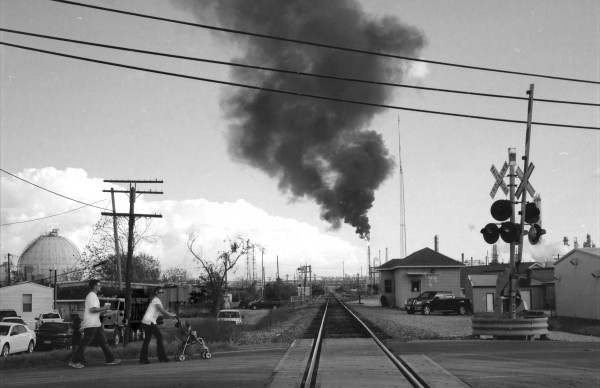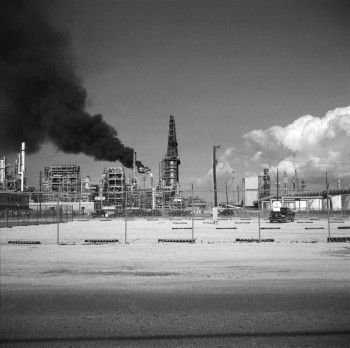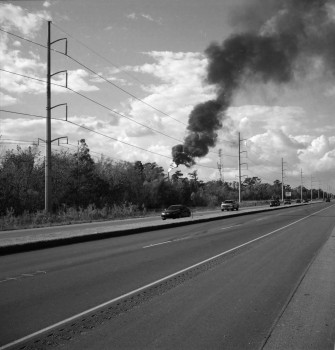by D. Acosta
photos by Breonne
 In the predawn morning of May 5th, 1988, the catalytic cracking unit went boom at the Shell Oil Refinery in Norco, Louisiana. The shockwave blossomed out in a twenty-mile radius. The intensity of the blast was 1/20th the size of the atomic bomb dropped over Nagasaki. My family’s home was five blocks away from the industrial fence line. It blew out all our windows. I was three years old and slept through the whole thing. My dad gingerly picked the glass off me, woke me up, and led my family through the lights and sirens of the evacuation zone to my grandma’s house ten miles up Airline Highway.
In the predawn morning of May 5th, 1988, the catalytic cracking unit went boom at the Shell Oil Refinery in Norco, Louisiana. The shockwave blossomed out in a twenty-mile radius. The intensity of the blast was 1/20th the size of the atomic bomb dropped over Nagasaki. My family’s home was five blocks away from the industrial fence line. It blew out all our windows. I was three years old and slept through the whole thing. My dad gingerly picked the glass off me, woke me up, and led my family through the lights and sirens of the evacuation zone to my grandma’s house ten miles up Airline Highway.
The blast presaged my childhood fascination with the neighboring oil refinery. I was 7 at the time that I first remember stopping and admiring it. I was playing for the St. Charles Parish junior basketball team. The refinery immediately surrounded our small gym on three sides. I would linger by the door before practice, admiring the neighboring architecture, the little particles of infrastructure that hung in an almost delicate unity. Smoke and wire, halogen and steel. It was the first vertical skyline I ever knew in that chronically flat Louisiana delta.

Observing the refinery became a frequent pastime of mine as I grew older. I spent many nights with friends on the roof of my parents’ house watching the flares pulse. We sat for hours drinking at the railroad line that led into the refinery. Teetering along pipelines, we’d balance ourselves over the bank of the Mississippi River. To me, oil infrastructure was esoteric, beautiful, and alive. I was awed as much by its aesthetic as its destructive potential.
My childhood fascination continued into adulthood. I began collecting and acquiring data on the oil industry in Norco and across the Gulf Coast. In graduate school, I aggregated all the spatial data of oil infrastructure in Louisiana on my hard drive into a single map. Pipelines, extraction sites, injection wells, abandoned barges and rigs, heliports, highways, shipping facilities, buffer zones. The map that this produced was a complex, frenetic crosshatch of information. It confirmed the sensation that I’d felt deep in my bones since I was a child: that oil infrastructure was embedded throughout the landscape of my life. It was not simply a fixture of the landscape; it formed the landscape, created and destroyed it.
The direct, concrete spatial influence of the petrochemical industry was nowhere more apparent to me than in a small quadrant of Norco called Diamond. My close childhood friend Chris grew up there. We used to give him rides to and from basketball practice. The Shell Chemical facility was located a couple blocks from Chris’ porch. If you walked half a block up, you’d run into the armored levee of the Mississippi River. If you turned around and walked a couple blocks down, you’d hit the Illinois Central Railroad. Turn right, and you’d intersect a linear thicket of undeveloped land called the Gaspard Line. Those were the square boundaries of Diamond: a chemical plant, a railroad, a levee, and some woods. I knew from visiting Chris that everyone within those boundaries was black and that nearly everyone beyond it was white. I didn’t understand the significance of that fact until years later.
Plantations in the region were historically located on the high ground of the Mississippi River. Freed slaves often settled on or near these same plantations to continue laboring as sharecroppers. When the petrochemical industry moved in, they required large swaths of cheap land beyond the flood zone with barge access to Gulf oil fields. Because plantation land met these criteria perfectly, the petrochemical plants became extravagant neighbors of the sharecropping communities that remained. Diamond is but one of many poor black “fence line” communities in the river parishes.
 Following increasing pressure by Diamond residents and their environmental justice allies, Shell entered into a negotiated buyout process, purchasing properties from fence line residents in Diamond and elsewhere in Norco. Through these buyouts, Shell acquired 70 acres of residential land. Most of that was located along the high ground natural levee of the Mississippi River. Chris’s house was once nested in a rich streetscape of old Creole cottages. Children played in the yards; you could hear the church choir singing on weekends from a few doors down. Now his house is one of the last ones standing. Today the porch looks out on a vacant buffer zone that gives way to the jagged skyline of Shell Chemical.
Following increasing pressure by Diamond residents and their environmental justice allies, Shell entered into a negotiated buyout process, purchasing properties from fence line residents in Diamond and elsewhere in Norco. Through these buyouts, Shell acquired 70 acres of residential land. Most of that was located along the high ground natural levee of the Mississippi River. Chris’s house was once nested in a rich streetscape of old Creole cottages. Children played in the yards; you could hear the church choir singing on weekends from a few doors down. Now his house is one of the last ones standing. Today the porch looks out on a vacant buffer zone that gives way to the jagged skyline of Shell Chemical.
By buying out Diamond residents, Shell further expanded its footprint in the “500-year floodplain”— a Federal Emergency Management Agency (FEMA) designation for the most elevated and least vulnerable real estate in the region. Half of all Norco property belongs to the petrochemical industry, and it accounts for 73% of all property within the 500-year flood plain. The acquisition of the most secure and least environmentally precarious land in the region was a hallmark of the industry from the beginning.
The Shell Chemical refinery first surrounded the Diamond community, creating inhospitable conditions for residents. The residents campaigned for home buyouts, and eventually got them. Now that neighborhood is gone, subsumed into refinery infrastructure, and the oil industry has further monopolized the high ground real estate of Norco. Over the course of my lifetime, I have watched an entire region of my hometown disappear due to the spatial logic of the petrochemical machine.
The oil industry can sometimes seem abstract. As urban residents, we rely on hidden infrastructure to conduct our daily routines—sewerage and water, electricity, wireless networks, etc. Oil and gas infrastructure is no different. But in Norco, that infrastructure is visible everywhere. It rises to the surface. It towers above the community, literally, with so much monolithic verticality that it’s impossible to ignore. The sadness, difficulty, danger, and surreal beauty that the industry brings become as much a fact of the physical landscape as the wind and the rain.
Share
Beautifully written and tragically real.